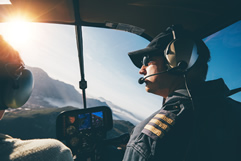
Scanning or cross-checking the various flight instruments on the instrument panel requires that the pilot’s eyes move in unison, that they stop and zoom-in to define clearly, the pertinent information to be gathering such as airspeed, altitude, course information and rate of climb or descent.
When aircraft speed is required to extend the flaps and landing gear, an exact speed schedule must be maintained. For the actual landing, the aircraft is proceeding at an average speed of 145 mph (Boeing 737) and a sink rate of approximately 700 feet per minute. The pilot must determine by visual cues (outside) when the aircraft is at the exact spot to pull the nose up, (to stop the rate of descent) and reduce thrust (to allow the aircraft to settle on the runway) from a point just a few inches off the runway. If the rate of descent is stopped too early, the airplane will drop onto the runway (bad landing) and if it is stopped too late, the aircraft will hit the runway at an excessive rate of descent (bad landing). This is further complicated by crosswinds. In a crosswind, the aircraft will be maintaining a “crab” angle (to compensate for wind drift) until just prior to touchdown. At the same time, the nose of the aircraft is raised, (to check the rate of descent), the proper amount of rudder pedal input must be applied to align the aircraft with the runway centerline, the wings maintained level and the thrust reduced.
The pilot’s ability to maintain concentration on the task at hand, (as in the supervision of flight instruments) and the allocation of his attention to these successive tasks is especially crucial under intense situations. Instrument flying and landings can be further complicated by aircraft failures (i.e. one engine rendered inoperative) or wind shears, which cause the instrument scan to include more details. Situations like these require instantaneous, calm, controlled responses, and also make well developed eye-hand coordination (to respond faster to the newly picked up cues) – an even more essential skill.

Judging the actual position of the aircraft, based on the information obtained from the flight instruments, is a prerequisite to accurate, rapid and smooth execution of the maneuvers, especially during the landing of the airplane. The aircraft may be flown on instruments to an altitude of 200 feet above the ground and forward visibility of 2600 feet (depending on actual weather and the approach facilities available). At this point, the pilot makes the transition to the use of visual cues obtained from outside of the aircraft (using depth perception and peripheral vision) as to the rate of sink of the aircraft and the amount of drift (caused by crosswinds) from the center line of the runway – backed up by quick instrument scans (which draw on speed and span of recognition skills and quick visual reaction ).
Fine motor coordination is required for the precise adjustments involved in the flight man oeuvres. The pilot must make accurate, smooth contact with the proper controls. This is exemplified in all phases of flight.
The pilot uses peripheral vision to maintain a constant awareness of the data being presented to him by way of his flight instruments and to pick-up cues in the panoramic horizon. Upon landing, when the aircraft crosses the threshold of the runway, (at an altitude of approximately 50 feet), the pilot no longer cross-checks his instruments, but depends only on visual cues outside of the aircraft to complete the landing.
Using the various instruments, the pilot must be able to locate and extract all pertinent information which indicates even slight variations in the aircraft’s flight pattern. A constant cross-check is required to insure that the R.M.I. (Radio Magnetic Indicators) correspond with the course bar in the horizontal situation indicator, and that the proper altitudes are achieved in relation to the position of the aircraft (as indicated by the altimeter), and that the speed is correct (airspeed indicator). Air speed is constantly changing due to the fact that the air the aircraft is travelling through is a constantly changing mass.
The pilot’s ability to rapidly process and interpret the visual information and to initiate a response based on the cues, determines his/her effectiveness during delicate man oeuvres and/or emergency situations.